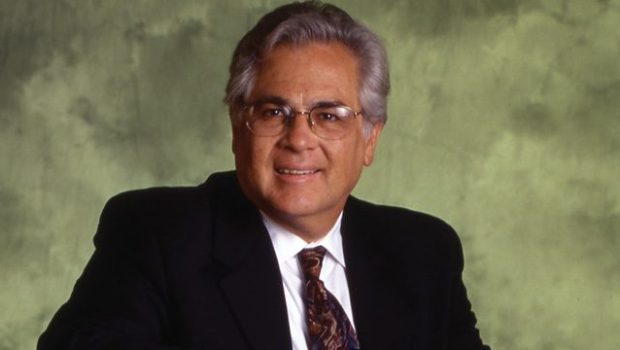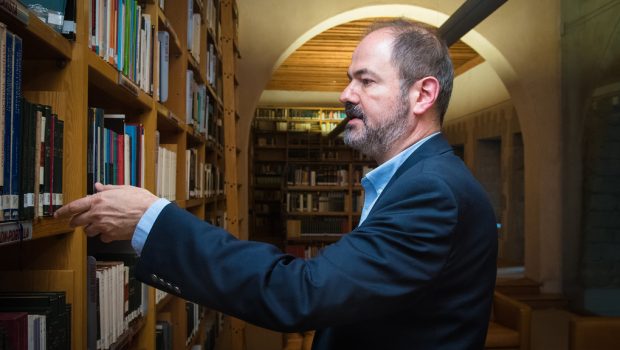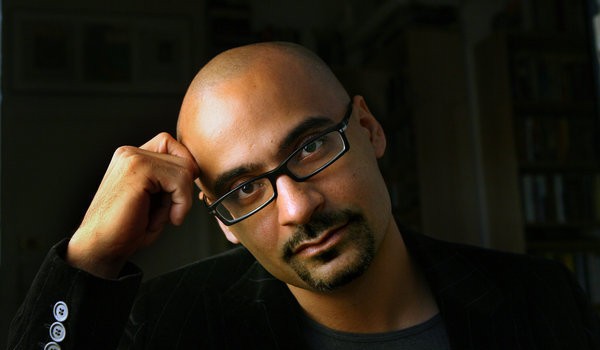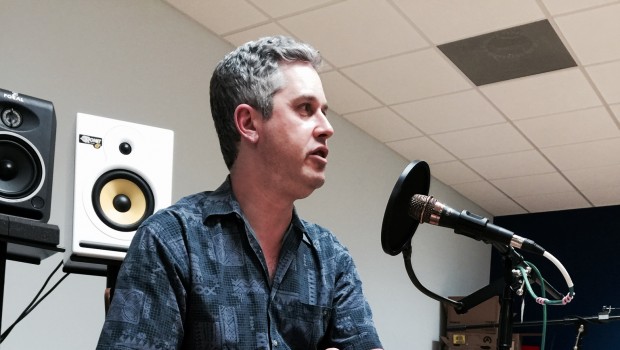The Arte Público Press: Interview with Nick Kanellos
Debra D. Andrist
Nick Kanellos is a hero—es un héroe, un salvavidas—he saved that which was disappearing beneath the waves of neglect and prejudice. He jumped into the shark-infested waters of publishing and public opinion, risking his own professional life, to save not only individuals but a collective identity. He has been the life preserver of dual access between writers and readers, buoyed up by the words and voices of nearly 300 bodies (of work) on a 25-year-old mission, not to mention those countless bodies heartened and inspired not to give up on themselves as their own heroes and she-roes.
Make no mistake, Nick Kanellos is no onemission wonder as founder and director of Arte Público Press in Houston. He also holds advanced degrees from prestigious universities, is author of prize-winning works, and has been a distinguished professor at the University of Houston since 1980. He was a pioneer in the field of Hispanic studies, establishing a literary magazine, Revista Chicano-riqueña, in 1973 in Gary, Indiana. It is still published as Américas. Kanellos founded Arte Público in Gary in 1979 and brought it with him to Houston the following year.
Kanellos’ impact cannot be overemphasized. The Press receives a couple of thousand submissions per year and selects about three dozen of the best to publish in Spanish, English and Spanglish. Arte Público is one of the few to still accept unsolicited manuscripts in addition to agent-submitted ones. About 30-40% of its production comes via each path, respectively. The books are affordable, accessible and stay in print. The authors are largely of Mexican American, Cuban American, and Puerto Rican descent, and the subject matter and intended audiences continue to grow, but always with Hispanic identity as the theme. Furthermore, the Press sends its authors on school tours nationally, some four dozen annually in Houston alone.
* * *
Debra D. Andrist: Nick, you’re a hero in the Latino community. Literally you’ve been a ‘salvavidas’, a lifesaver, for many Hispanic heritage writers who had no other avenue for publishing their works. Historically, how did it happen that you started such a unique enterprise?
Nick Kanellos: I had been involved in the Civil Rights Movement of Latinos in the 1960’s and while I was in graduate school at the University of Texas and working with what was called back then, Chicano theatre, we dramatized the struggle for the workers’ rights, for unions, for voting rights and what have you. We popularized all these political issues through theatre. In that struggle, I got to know lots of artists and writers from all over the country, Latinos who were involved in using their art to further the civil rights of Latinos in the United States: educational rights, working for bilingual education, for integration in all areas from public accommodations to integrating the university and the schools. It became evident that all these writers had a tremendous talent and no place to publish.
So, in 1973, we founded a literary magazine for national distribution, Revista Chicanoriqueña. That magazine did quite well introducing many of the writers of today in Latino literature to common household names. By 1979 we had been doing special issues of the magazine and one of these issues was a nice fat volume, an anthology, Nuevos Pasos. We also published a special anthology of Latina literature and others, so we knew that we could publish books.
By ‘79, we decided to grow the magazine into a publishing house and we founded Arte Público as an extension ofRevista Chicanoriqueña. The publishing house grew during the l980’s and especially during the 1990’s. That’s where we are, that’s how we got involved in this, out in areas where we were not in the center of the publishing industry so we had to invent a lot of what we were doing. We didn’t have access to consulting and people who were knowledgeable and experienced in publishing but during the 80’s a lot of that changed because we were able to get funding. As we became better known, we were able to bring in people from publishing industries to help us out and give us advice and consultancy.
D. D. A.: You mentioned in a newspaper interview that a pivotal event for Arte Público was the book Rain of Gold. How did that change where Arte Público was going or what it was doing?
N. K.: By the mid 80’s, the movement for curricular reform at universities throughout the United States was growing and some leadership institutions, such as Stanford, were beginning to incorporate “Third World” type literature into their curriculum. Through that, more and more work by minorities became known. In fact, one of our books was one of the books that was chosen for that curriculum and it was word about the book that got around through academia and finally was breaking into the general public.
Quite often that was discussed negatively because when our book, The House on Mango Street (by Sandra Cisneros), got into Stanford, The Wall Street Journal published a banner headline in its editorial page, “The Great Books Replaced by the Not So Great,” and they were talking about our books. But that helped because then more of the general public got to learn about our books. Then we started to be able to sell our books to bookstores. Up to that point, the mid 1980’s, we basically grew up within academia and we were supplying the whole movement for studying Latino literature in colleges. Our books were going into Spanish departments, English departments, ethnic studies courses, women’s studies, but basically, it was a campus deal. By the mid’ 80’s that began to change and people outside of academia began to hear about our books and we were able to start touring writers to bookstores and doing promotions in bookstores and to get more and more into the general public.
But what really, really took us to the general public was when around 1990 a very, very important book, an autobiography, a non-fiction work by Victor Villaseñor, was signed up by a publishing house in New York, a very big house. The publishing house tried to change the nature of the book, from a non-fiction work, something that was true, a true family autobiography into a fiction work, a romance of the west. They even wanted to change the title from Rain of Gold to Río Grande. The author revolted, bought his contract back, and brought the book to us.
We had never published a book in hard cover and we had never attempted to compete with the large industry for newspaper attention, for best-seller classification, for widespread distribution through all the major bookstores in the United States. This was our experiment and this was the first time we ever did that. We were able to publish Rain of Gold in hard cover. Through lots of promotion and lots of newspaper stories about the book and the whole experience, the book became a bestseller. To even to make it a best seller, we had to go and hit up our distribution system, start up a distribution system. We had to get sales reps, commissions sales reps for all the bookstores. We had to find out about all the nature of reviewing media because as a rule we were not interested in that, all of the newspapers in the country that reviewed books, because the bookstores were not going to be buying our books that way. We were mostly in the college market. We did that and the book became a bestseller.
Not only did it become a verified bestseller in the West, we were also able to sell the rights. We had an auction in the big commercial industry for the rights of the book and it was bought by one of the biggest publishing houses in the United States and the world, called Bantam Doubleday Bell. They reissued the book in paperback and we are still receiving royalties, the author is, from that because the book has sold well over 200,000 copies today. We published other books by this author and then we also sold those to Bantam Doubleday Bell.
That was the beginning of what we call in the industry “front-list publishing.” That means competing with new books for major attention in newspapers and bookstores for big sales and to do that you have to sustain author tours to bookstores and to get interviewed around the country. It entails a lot of investment, a lot of money, and it entails a product that is more commercially-oriented, something that is not so elite.
Since then we have been doing that. A certain number of books every year vie for attention in that market and we have had a number of best sellers since then. That also has led to us selling rights to movies. We have sold many rights to movies on TV. To date, we have only had productions by the Corporation for Public Broadcasting. We had some of our books made into movies but we are still waiting for big a commercial release. Who knows? One of the contracts that we may have, that we have out there, may eventually become a big film release. That has also helped sustain our foreign rights, all our foreign rights that we sell around the country. Since then, we have been able to maintain national distribution to the general audiences to the extent that this has become the major market for Arte Público Press. We sell more books to the general audience, people we don’t know, we have no idea who is going and buying the books, we don’t even know how they find them there, than we do to academia or to libraries or to secondary and primary education schools. So it’s a pretty rags-to-riches story there. Although we are not rich…but we had nothing before.
D. D. A.: We might also mention that Arte Público has now gone into grocery stores and the children’s books section.
N. K.: It has always been one of our dreams that this literature, which has very strong grass roots ties that come from Latino communities in the United States, would have the capability of reaching back into those communities and be the reading matter for just everyday people. So with that idea in mind, with that idealism, we said that we wanted to get to the everyday working people. Where would we find them? We would find them in the Latino supermarkets! We had a 66% sell-through rate, which is right up there with Time magazine. That means that two thirds of what we put on the rack sells. In those racks we heavily place children’s literature, children’s books, because we know that the priority among Latinos is the education of their kids, and reading and literacy is very important. But our message also is that they should have the opportunity to read from within their culture and that our books will serve as a bridge between the home and the schools, so that they can start learning to read with things about which they are familiar. However, one third of the rack is adult literature, literature written in Spanish, and the people pick it up and read it. Well, let me say that all of those books are books that are quality and elite books. They’re not really novelas, photo novelas; they’re not genre books like westerns or romances or anything else. We are dealing with books that are written by some of the most outstanding writers of Latino literature and they are being consumed. People are buying them. It’s really a wonderful experiment; it’s proving that everyday people can read this literature and enjoy it.
D. D. A.: I noticed that on your children’s literature books the titles are in English and in Spanish.
N. K.: It’s for learning; it’s for people who either read Spanish or English and for bilingual education. But it’s also for kids to take home and have their parents read to them and if their parents don’t read English, they can read it to them in Spanish. Now my son, who is bilingual, he reads both versions on the page before he turns the page. So he’ll read the English and then he’ll read the Spanish, then he’ll turn the page. So he reads it twice.
D. D. A.: Do you publish all your books in both languages?
N. K.: No. We just select the text that we have available in both languages. Usually we prefer to publish the Spanish original or the English original. Now what happens is that we have to publish most of our adult literature books in English because in the United States there aren’t adequate systems of review and distribution of books in Spanish. So if we published more books in Spanish at this point, we’d be suffering financially.
D. D. A.: It’d be for a very limited audience.
N. K.: It’d be for a very limited audience, yes. We get at least 40% of our submissions in Spanish but at this point at least 80-85% of our books are in English.
D. D. A.: So if you had anything submitted in Spanish, would you have to translate it into English?
N. K.: Sometimes, in fact, there has been a strategy for some of our more recent books in Spanish. We issue the English translation first. It gets reviewed around the country and it establishes a track record for itself. Then we will publish the Spanish. Then the librarians and the bookstores will know what it’s about and it’s gotten all this credit so then they’ll order it. Just an unknown Spanish title could just be plowed under; get lost in the market place. Because, you know, just think about it: Houston Chronicle doesn’t review books in Spanish.
There’s really one Spanish language general bookstore in Houston and there are probably some hundred or so bookstores in Houston that mainly deal with English materials. So those are the odds you’re working on, not to mention all the wholesalers and distributors and librarians who don’t know Spanish, don’t have the least inkling about what the book is about. That’s why in our catalogs as well, even though a book may be in Spanish, the description in the catalog will be in English. So that the librarian, the buyer at the bookstore, the bookstore chain will know what the book is about. It’s hard but they know that it’s changing. There’ll be more and more opportunities for distribution in Spanish, yearly. Everything is changing very fast.
D. D. A.: You also published Latin American classics known by Anglo-American literature in the U.S?
N. K.: Just books on Hispanic culture and history in the U.S. It depends how you define Latin American culture and literature. Because the literature of Latinos in the United States is transnational, there are inputs and outputs. We share writers with the Spanish-speaking world. For instance, one of our “Recovery” books is a bilingual edition of Versos sencillos by José Martí who is a great, great figure of the U.S.-Latino literature and a major figure of Cuban literature. But most Cuban literature of the nineteenth and early twentieth century was produced outside of Cuba. And as part of “Recovery,” we published the first translation of the complete Versos sencillos that was ever done. Incredible that it had never been done before and, in a bilingual edition, it has done very, very well. He is a U.S. – Hispanic author, he lived in the United States for more than ten years, he produced much of his major work here in the United States. But he is also Cuban; he is a Cuban national author. He is the canonized author of Cuba, probably the top author ever canonized by Cuban culture. We have other figures like that. There are more novels of the Mexican Revolution written and published in the United States than there were in Mexico and most of them were written by political refugees. So that is part of our concern.
But you can see how this literature is transnational because the literature is made up of three main groups. It’s made up of people who consider themselves natives from, not time immemorial but at least from the colonial period, the period of exploration and colonization, and whose roots trace all the way back from here to there. Or people who at one point—the eighteenth, nineteenth, early twentieth century, or just ten years ago—became naturalized citizens, or the children of immigrants. Then there’s the literature of exiles, political refugees, and the literature of immigrants. Immigration into the United States by Spanish-speaking people began in more or less 1635 with the Sepharim (Jewish immigrants expelled or exiled from Spain). They went up into the northeast and then were followed by Cubans and Spaniards that ended up all along the coast from Georgia to Massachusetts and then continued. The first really economic refugees, wholesale, were during the Civil War.
Immediately after the Civil War, the South— what became the Southwest—was looking for a way to replace slavery as a basis for their agricultural industry and they began importing Mexican labor, in the 1860’s. That system spread all the way to the West and it’s still in effect today, of importing poor people from rural areas to do the service and the agriculture and the hard labor in the United States. So for more than half a century, that has become the largest sector of Latinos in the United States. They are working class people that have been recruited or drawn to the United States to make a living from the Caribbean, Mexico, from Central America. Immigrant literature is a very, very important part of all this tradition and it also has been the basis for the creation of more and more native literature: their children, and their children’s children, and what have you.
D. D. A.: Not only have you and Arte Público been pioneering in the publication of Latino content, Latino-themed works but by Latino authors as well. Now you are involved in this new project, Recovery, which exploits technology and uses it as well. Will you comment on that direction?
N. K.: A cohort of scholars, about my age, weathered the pitfalls of our careers in academia for some twenty years before we were able to do something like this. I’m part of a generation of scholars that got their Ph.D.s at the end of the ‘60s/beginning of the ‘70s in literature who always knew that there was a strong historical/literary/ cultural presence of Latinos in the United States but it was nowhere to be found in academia and in libraries and in other institutions. Needless to say, it was never in our textbooks and in our classrooms.
So over the years, for some twenty years easily, those of us who were not fired because we didn’t have tenure and survived our way to becoming senior professors had all along been researching this literature. In around 1990, I brought scholars together from around the country, some twenty-five scholars, who had been working on this literature. I proposed a project for all of us to work on: finding the literature, saving it, and making it accessible. We could only do this at this point in history because, first of all, we now had a core of scholars who were secure in their careers. They had all gotten tenure and had all become senior professors. Therefore, their careers were no longer at risk because they were doing Latino stuff that was unknown and disparaged.
Second, at this point in history, technology had progressed so much that we could affect a lot of the search electronically. We had a lot of the search engines, we had the hardware, we had the know-how, and we could put it in the service of research in the humanities which was still is still very new when it comes to how you use technology when doing humanistic research.
The third element that we needed was money. And we have gotten support from numerous foundations but the main support and the vision came from the Rockefeller Foundation, from the beginning, which made a commitment of ten years to the project to the tune of over three million dollars and so we began. We began doing the research, having the conferences, publishing the books, microfilming material wherever it had to be saved, bringing scholars together in one form or another to work on all of these aspects, involving graduate students. Along the way we also made this program “Recovery,” the U.S. of Familia Heritage, and Arte Público as kind of the centerpieces of our master’s and Ph.D. programs here at the University of Houston. That has worked out quite well. We are one of the few areas that produces the complete scholar in Latino literature and language in the United States. But we work with scholars and graduate students around the country and our archives are open to their work on their subjects. We in fact included in the project to provide money for them to do research on a competitive basis. We offer grants-in-aid and we offer all other kinds of support: travel support and material support to do this research. We are in our eighth year and I believe we have accomplished a great deal although the greatest proportion of the work that is to be accomplished, that will be accomplished, is electronic. And that will be putting those hundreds of thousands of manuscripts at the fingertips of people from around the world over the internet.
D. D. A.: What do you want to do next?
N. K.: We want to become fully interfaced with students and teachers around the country through the internet. We want to be able to deliver not only books but all the other kind of peripheral, teacher’s guides, sound files, visual files, everything that will expand on Latino literature and culture. That will also be accessible to students and teachers around the country through our web sites. So we are working on that now and of course we want to deliver all the “Recovery” material over the internet.
I guess that is a big enough project for now. We do not kill ourselves to become bestsellers and buy with the large industry. We know that we are very specialized but we have a lot of emphasis now on expanding in education, in primary and secondary education. So we are devoting a lot of energy and finances towards getting the books in the hands of students around the country. It’s a hard nut to crack because education is so decentralized in the United States and every school system has its own way of ordering things, has its own rules and regulations, and it’s very costly and very intense trying to reach them.
D. D. A.: But, that’s an exciting challenge!
• Reprinted in part, by permission of South Central Review
Posted: April 2, 2012 at 6:25 am











Hello there! I know this is kinda off topic however , I’d figured I’d ask.
Would you be interested in trading links or maybe guest writing a blog article or vice-versa?
My blog goes over a lot of the same subjects as yours and I feel we could greatly benefit from each other.
If you’re interested feel free to shoot me an email.
I look forward to hearing from you! Terrific blog by the way!
Sure, send us an e mail with what you have in mind
Keep on writing, greast job!